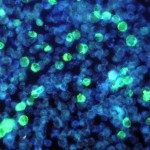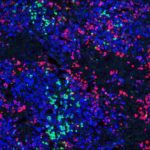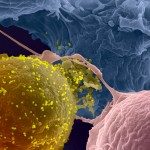Lien vers Pubmed [PMID] – 30888052
Lien DOI – 10.1002/eji.201848001
Eur J Immunol 2019 06; 49(6): 954-965
Human immune system (HIS) mouse models provide a robust in vivo platform to study human immunity. Nevertheless, the signals that guide human lymphocyte differentiation in HIS mice remain poorly understood. Here, we have developed a novel Balb/c Rag2-/- Il2rg-/- SirpaNOD (BRGS) HIS mouse model expressing human HLA-A2 and -DR2 transgenes (BRGSA2DR2). When comparing BRGS and BRGSA2DR2 HIS mice engrafted with human CD34+ stem cells, a more rapid emergence of T cells in the circulation of hosts bearing human HLA was shown, which may reflect a more efficient human T-cell development in the mouse thymus. Development of CD4+ and CD8+ T cells was accelerated in BRGSA2DR2 HIS mice and generated more balanced B and T-cell compartments in peripheral lymphoid organs. Both B- and T-cell function appeared enhanced in the presence of human HLA transgenes with higher levels of class switched Ig, increased percentages of polyfunctional T cells and clear evidence for antigen-specific T-cell responses following immunization. Taken together, the presence of human HLA class I and II molecules can improve multiple aspects of human B- and T-cell homeostasis and function in the BRGS-based HIS mouse model.











